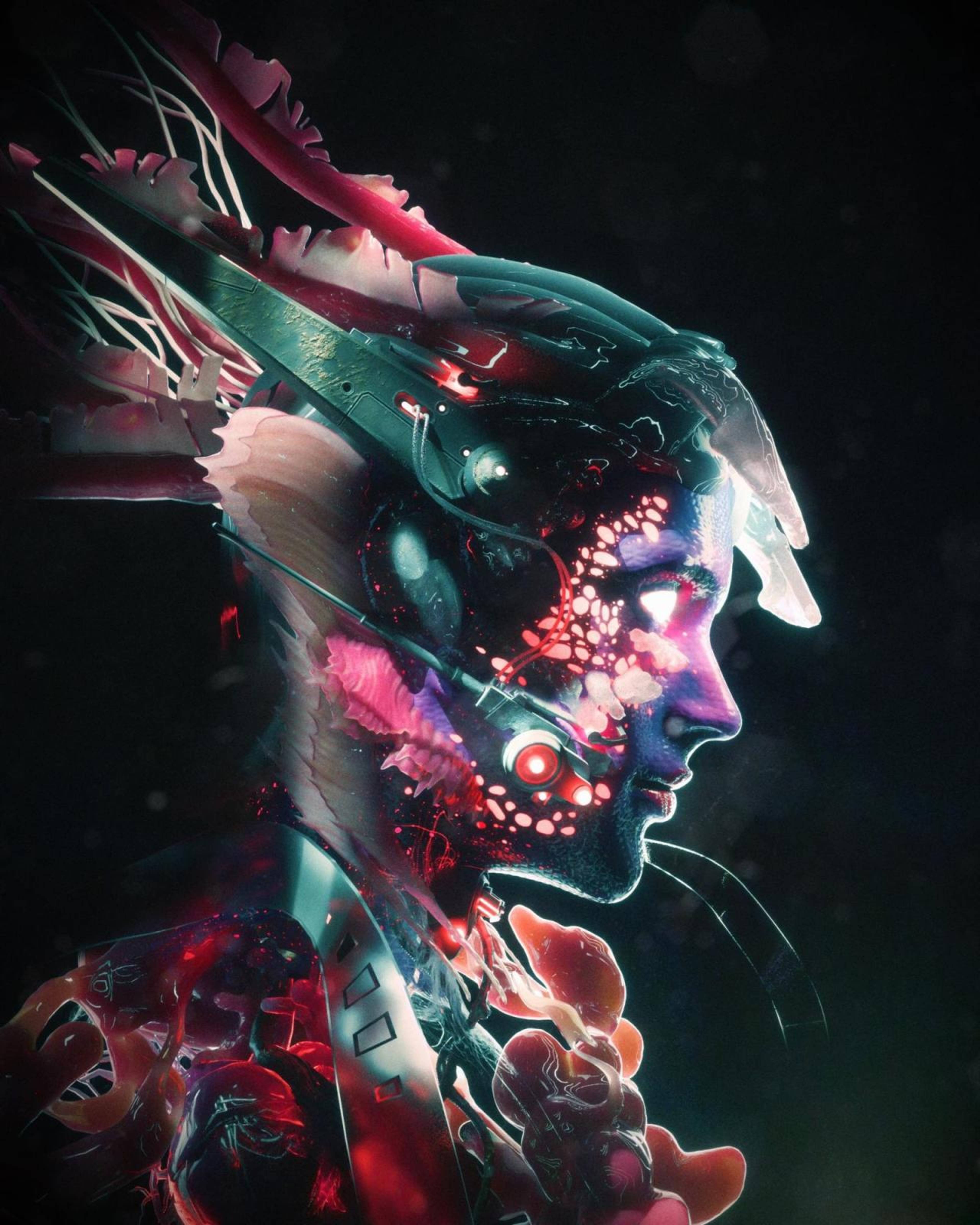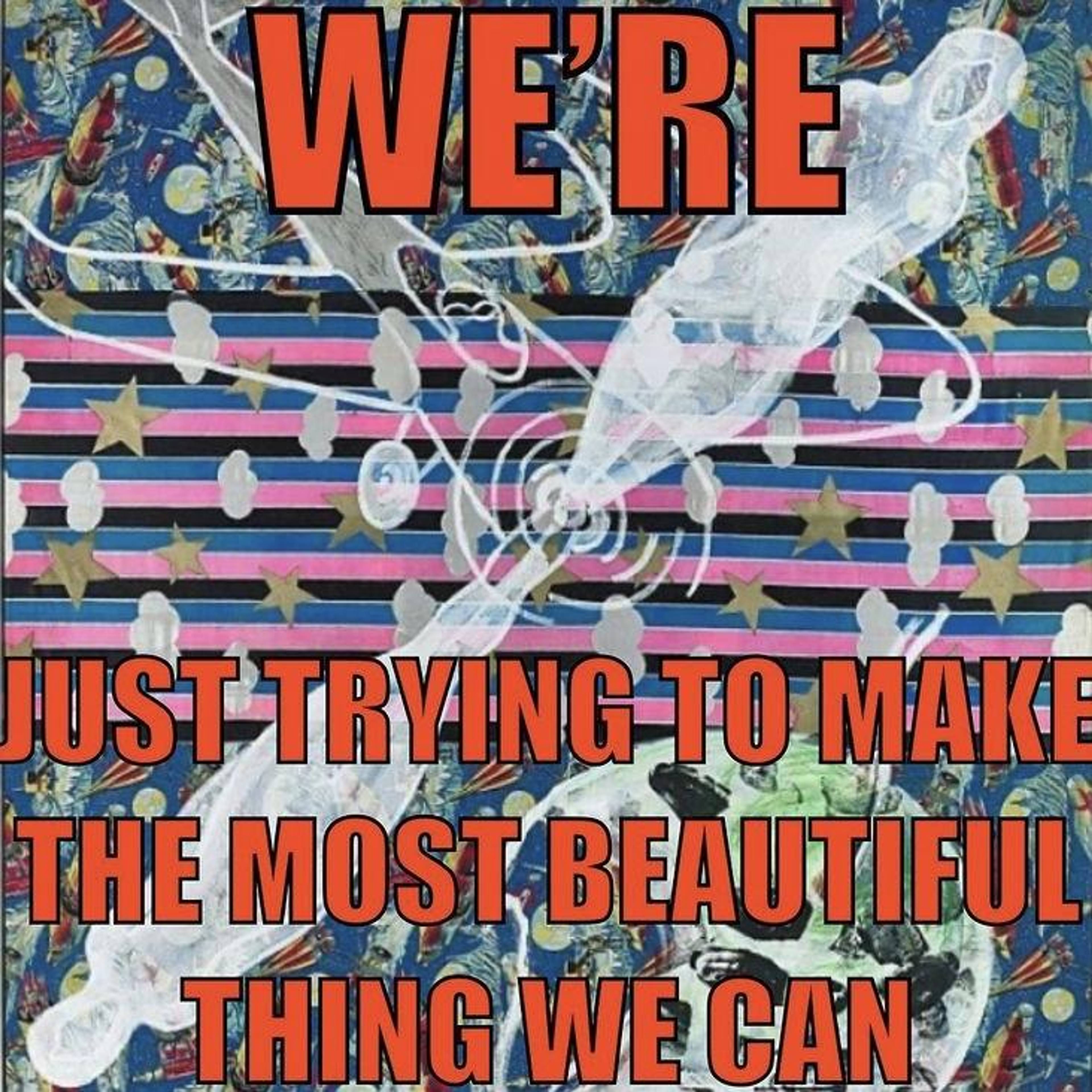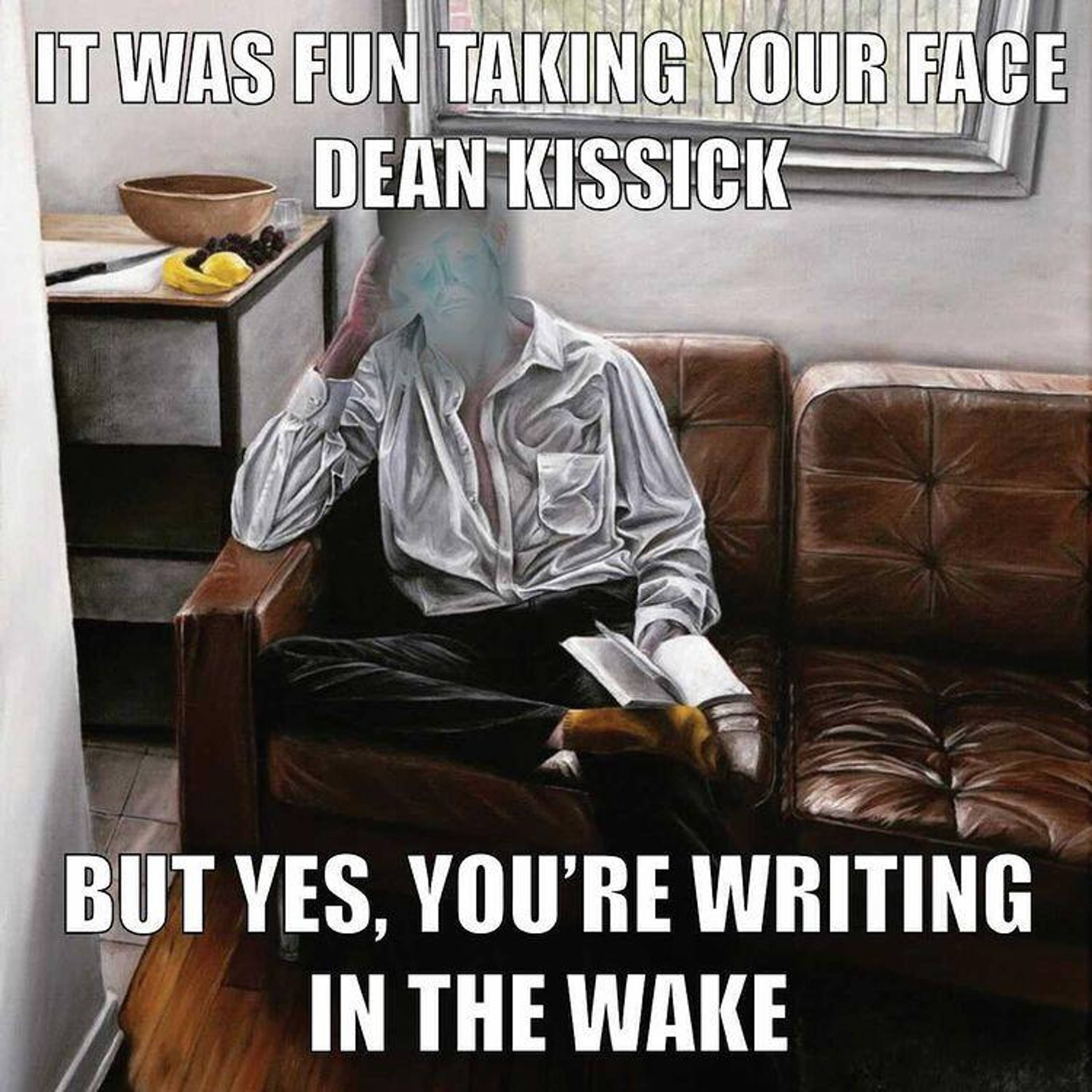Last month’s column left off with two pop stars pointing towards two different paths: to embrace cybernetic posthumanity, or destroy one’s identity. Since then, Kanye West has gone a step further, dressing in an oversised Stop Making Sense –era David Byrne suit and Roman theatre mask and singing a dreadful version of “Runaway” at a society wedding in Venice. As critic Max Lakin noted, “Kanye performing at the Arnault kid’s wedding and being totally indecipherable because of his extended meditation on identity is very funny”.
Now is a moment of masks and the hard-to-decipher. There has been much speculation in certain quarters about whether there is one US president, or many interchangeable presidents and body doubles, or a sleepy, malfunctioning hologram whose hands appear to pass through solid objects. Others have wondered who former president Trump was speaking to that Hallowe’en, in the faceless black bodysuit? Was that his son in there? What happened to his piss tape from the Ritz? Did Jeffrey Epstein really die or was a pretend corpse brought out for the cameras? Does Travis Scott worship the devil? Was his album art inspired by old Netherlandish paintings of hell? Reality often is said to be glitching. Doppelgängers and alters are everywhere. We live in a slapstick, a Tintin adventure, an uncanny space of doubling and tripling, of smoke and mirrors and red herrings. We can’t trust our own eyes. Anyone might be a clone.
Faces are changed and swapped with ease with a phone. It’s simple to place your own face onto others’, onto found footage, video game characters, pornography, dance floors where everyone looks just like you. That might be the entertainment of tomorrow: going to the cinema and watching movies where all the characters are you. Where someone who looks exactly like you, only better, falls in love with someone who looks just like your unrequited love. That’s how I imagine Meta (Mark Zuckerberg’s new metaverse project) will be: a glowing, immersive karaoke of unfulfilled desires and personal failings, full of your friends whom you no longer see in real life anymore. A Charlie Kaufman movie. The opposite of Kanye’s facelessness; not to hide your face, but rather make everything your face. Although perhaps those approaches are not so different. Although perhaps they are the same.
In the attention economy, faces and images are borrowed and swapped to the point of credit spiral. If you can see your face everywhere, and see everything in your face, that leads to facelessness.
Angelicism01, the anonymous writer at the heart of many of this year’s meditations on identity, who has recently disappeared, but will hopefully someday return, wrote, of video clips like these, “In fact, our Frankenstein movies have themselves been sublated onto zeroiqhonorlevy’s manganese physiognomical Facetune vaudeville and what will have been its clones, where every head, especially the real headz, becomes every other, facialisation pushed to the point of credit spiral and complete facelessness as in the first line of Hölderlin’s Antígona ” (that first line being something like, “There is nothing – no pain, no ruin, no shame, nor dishonor – that I have not seen in your sufferings and mine”, although I don’t have Hölderlin’s version, let alone a translation). In the attention economy, faces and images are borrowed and swapped to the point of credit spiral. If you can see your face everywhere, and see everything in your face, that leads to facelessness.
Demna Gvasalia has in the past compared himself to Marcel Duchamp, in relation to the idea of the readymade, the found object. His readymades are found people and ways of dressing he can play around with. Faceshopping, -swapping and -tuning software, likewise, also makes people into found objects ready for metamorphosis. It’s another form of masking because it makes you look like something else, and gives everything else the potential to look like you. It’s also part of a larger paradigm shift: photography is now used to construct new images rather than to represent the world outside. Photography and CGI are blending ever closer together.
In 2018, Dazed magazine launched its Dazed Beauty platform with a bold proposition for the style industry: a series of deliberately grotesque and unnatural models of beauty, and a new approach to making fashion imagery; rather than commissioning photographers, directors or illustrators, each story was made by a 3D artist who scanned their subject’s body and then sculpted and painted it using modelling software. Singer Arca, for instance, became a see-through agglomeration of blood vessels, organs and factory parts. (This approach has since been dropped, but was likely just ahead of its time, and prohibitively expensive.)
Arca by Carlos Saéz, Dazed Beauty issue 0, 2018
Here, again, the body was appropriated as raw material. No longer a container for our identity, but rather a jumping-off point. The underlying idea was that our fluid identities demand fluid representations, untethered from the physical body, with which to express our true selves. Identity would become an idol we sculpt afresh each morning from the digital clay; and this is also what was more recently promised by Meta, the campaign video for which shows a cabaret entertainer, a Toulouse-Lautrec star for the corporate metaverse, putting on makeup, a blue dress, and a golden crown and asking us to “imagine a world where we are represented the way we want to be”.
There are no more faces. There is no more Facebook. Only Meta, the land of masks, which reveal the authentic you, we’re told. And it does already sometimes feel like the characters we play are more real than the people we grew up as. And some of us do feel trapped in our bodies, and in the world.
Digital artist Manny404 once said that his body was a prison. A few years ago I asked him, over brunch at Mogador in the East Village, “Do you really feel like your body is a prison?” and he said yes, “Because basically just existence in general is pretty miserable. Even the most successful people are constantly hungry, aching, starving, sick, tired. It’s just life is constant pain”. He once made a popular digital model of himself in his underpants and gave it away for free, for others to do as they pleased with. For a few nights it danced over the giant screens of Times Square. “I am interested in being the puppet master”, he told me, “but then training the puppet to the point where you drop the puppet strings and it’s gone: basically puppeteering at scale”. It’s backwards Pinocchio: the real boy made into a puppet. You wish upon a star that you no longer have to be real; that you might recede, with everything else, into the imagination and the entertainment. Since we last spoke, he has also released a series of collectible NFTs of himself.
“What’s more ubiquitous and of the zeitgeist”, Julia Morrison, an artist from Palo Alto, Silicon Valley, writes of her own Caligula Triptych NFT, “than a horny rich dude sliding into a girl’s DM? A moment in time, like Jackson Pollock drips paint on a canvas.” Her triptych is made of three screenshots of an unsolicited conversation she had with The Social Network star and alleged cannibal fetishist Armie Hammer. While Richard Prince has made paintings of Instagram posts, Morrison has gone further and minted screengrabs of direct messages. Now every human interaction might become a found object and a financial derivative. Any private correspondence might be arranged in the triptych form of an altar and shamed in public. Everything you say can be stored on a blockchain forever, and traded; the entire social sphere can be cannibalised. It’s a touch worrying. We may well deserve to be mocked and pilloried for the messages we’ve sent in our lives, but can still hope they’re never sold as NFTs.
On the question of whether her screenshots are art, Morrison writes , “Let me put it this way: Armie Hammer made himself into a meme, and I made him into the next Campbell Soup Can”. Warhol himself had some unrealised money-making schemes that now seem remarkably prescient. He once proposed leasing out his Factory “superstars” for $5,000 each, decades before influencers began hiring themselves out for walkthroughs at parties and Cameo personalised videos. He also suggested selling Hollywood stars’ used underwear ages before the young “Bling Ring” gang tore through the Hollywood Hills breaking into celebrities’ houses and stealing their clothes and accessories, in search of luxury goods blessed with the aura of Paris Hilton or Lindsay Lohan. They weren’t after material goods so much as magical objects blessed by the modern-day cult of celebrity. Magical objects they might wear themselves, as a sort of voodoo possession or transference of aura. We’ve come to desire personalities, not objects. This is also what underpins the social clothing resale site Depop: that you can buy a part of somebody, their personal style, their identity, and make it a part of your own story. And this happens in many different ways now.
This year I was going to keep a diary of every new meme format, in the hope of writing about them. But there were no new meme formats. Rather, memes began to be used in new ways. Summer brought, like mayflies on the river, a flash phenomenon of “cells” accounts that bloomed intensely and deliriously and have now burnt out. It began last year with Incellectuals, an Instagram meme account run anonymously by some New York art world types, followed by Jonrafmancellectuals, which gave shape to the form: fast-flowing memes, sometimes cruel, sometimes funny, about extremely niche subcultural figures, in this case post-internet artists and their hangers-on. And after Jonrafmancellectuals, the deluge.
Meme by Containcellectuals, 2021
There was Angelicellectuals, Containcellectuals, Howlonggonecellectuals, Ioncellectuals, Taolincellectuals, Wetbraincellectuals, Cellectualcellectuals, and so on, most of which were eventually banned, or have just disappeared or ground to a stop. On these pages, fan culture and meme culture were combined in novel ways. Most of the posts were not jokes, but copies of images other people posted and things they said, collaged, combined, and remade to be weirder. A postmodern act, Sean Monahan writes in our current print issue #69, of “making content out of content”. There was clowning, shitposting (absurdist posting intended to confuse or provoke), hard-to-parse esoteric nonsense, quotations and found images, beautiful sentiment, deconstructions of identity, annoyance and frustration, all joined by a shared aesthetic of bold text and degraded images. The anonymous authors of these different accounts were concerned with what was happening right then in the moment, rather than in the past, and riffed off of each another, and in the stream everything came together in a serial photomontage, a post-bricolage of found content. It’s a new way of making what Hito Steyerl calls “poor images” ; the discarded ghosts of images.
Anonymity is an appropriate response to a time when nobody will shut up about themselves. It returns some mystery to life. To look for the author behind Angelicism01 is to miss the point; what’s interesting is what was said, and how, and the choir of clone accounts, angels without faces, that appeared around it, until it was hard to tell how they might be connected, where the original was, and was not, and whether that even mattered. The phenomenon of Angelicism and the clones can be read as an attack on the cult of the individual in art and in writing. It opened a space in which the individual was not important. Similarly, the cells weren’t just making fun of individuals but the whole Millennial model of sharing your life online. They understood, Monahan concludes, “What we Washed Millennials long ago forgot in our dogged pursuit of personal brands: the internet is magic when it’s not real life”. It’s an imaginary space we’ve made for ourselves. It could be whatever we want it to be. We don’t all have to take everything so seriously here all the time.
The world, in our prevailing conception, only exists as we perceive it, feel about it and relate it to ourself; but that self can also be blown apart, hidden, cloned, given away.
As the cells’ authors were cloaked in anonymity, the flow of social media was reversed: rather than expressing themselves, they would take the lives of others and perform them. You can be more true to yourself behind a mask; not only because you could be represented how you want, like the Meta campaign promises, but just as well because you don’t have to be represented at all, you can stay hidden in the shadows, like old Japanese bunraku puppeteers dressed in black, or assume many forms. Many of us like to pretend to be somebody else (Facebook, of all companies, must know this). As Tom Tuna has noted, “Some of these cellectuals accounts are better at posting ‘you’ than you are posting yourself. Lol fuck”. Today, you are whatever everyone else says you are.
For a while I became a wonderful terrible meme. There was a “Black Dean Kissick”, there were other versions of myself as different races, genders, ages, religions, made by people I’ve likely never met, posts I’ve made collaged into new ones, and posts and blogs about how dumb this column is; all fair enough, although I did find the blackface representations alarming (the art world is quite sensitive on the topic of race), and saw some posts that really freaked me out. The algorithm becomes intense at moments like this. It kept showing me twisted versions of myself as soon as I opened Instagram, and I was tagged in other posts, and friends would send them to me, and I felt, at times, as though the walls of the internet were closing in around me. Each night my notifications would draw me, like a good novelist their characters, into my own small personal hell. But during those moments I was freaking out, spiralling, I’d tell myself, “This is a very contemporary experience”, and so I was glad to have it.
In midsummer, I went to a party where a friend told me I wouldn’t be a meme for long and that I would be sad when it was over, and he was right, and now that it’s gone I long for those balmy paranoid summer nights, and every meme is a blessing, really.
The cells are gone too. Last week I was messaging Angelicellectuals (we’d never spoken before) and they told me the cells are over. At the end of our conversation, they sent me this:
Meme by Angelicellectuals, after the painting The Writer by Srijon Chowdury, 2021
A couple weeks before, I’d met up for a coffee with a completely anonymous account, from Twitter. I had no idea of their age, gender, anything, and hadn’t asked, but the tone of their message was interesting, and I didn’t think they were going to kill me. As it turned out, quite the opposite. After we’d sat down, they mentioned they were an actor who’d appeared on a sci-fi show, “a D-list celebrity”, they said, and had recently moved to New York, and for the past year or so they couldn’t stop thinking about destroying their identity. I suggested they do so, of course, if they could. But it’s an idea that I, as an individualist who’s arranged my whole life around the arts, and cannot, and does not really want to, escape the cult of self-expression, could never countenance.
The sacred goat of modern art is the artist’s unique identity and perspective. It’s the one thing that cannot be violated or sacrificed: individuality, as reaffirmed by self-expression, by the bottomless self-reflexivity of autofiction, the self-referentiality of figurative painting, by our newfound obsession with the race, gender, sexuality, disability or otherness of the artist. Fetishising the artist’s identity and worshipping the internet star’s performance of themselves are just two faces of the same coin. It all comes back to the individual; and the greatest transgression still possible in culture, that I can think of, would be to somehow relinquish that individuality.
As social media, fashion and rap all revolve around self-expression and self-construction, it’s been surprising to see each repurposed for anonymous and deconstructive enterprises as of late. This summer we encountered many of those that cannot be seen. Anons speaking in tongues. Cells and their admins. Angels and clones. Spectral noppera-bō . Rappers without faces living in busy stadiums. Phantoms, each, of the bright opera of life.
The world, in our prevailing conception, only exists as we perceive it, feel about it and relate it to ourself; but that self can also be blown apart, hidden, cloned, given away. One approach to conjuring new experiences is to leave our bodies and self-expression behind and give ourselves over to something greater. To try and reach a sort of ego death through posting, rather than psychedelics or masks. That might lead to new ways to express what recent art and literature have so far not been able to express well: how different it feels to be alive in the late 2010s and 2020s, and how the internet has radically changed our conception of the self. It’s been another strange year; I’m looking forward to seeing what comes next.
Last month, Dean Kissick penned Part I of this column here.





